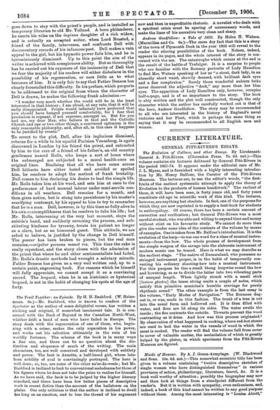C URRENT LITER IT UR E.
GENERAL PITT-RIYERS'S ESSAYS.
The Evolution of Culture, and other Essays. By Lieutenant- General A. Pitt-Rivers. (Clarendon Press. 7s. 6d. net.)—This volume contains six lectures delivered by General Pitt-Rivers in the period 1867-74. It appears under the editorial care of Mr. J. L. Myres, and is furnished with a highly interesting introduc- tion by Mr. Henry Balfour, the Curator of the Pitt-Rivers Museum. The lectures are, to use the editor's words, "the first- fruits of the earliest systematic attempt to apply the theory of Evolution to the products of human handiwork." The earliest of them, it will have been seen, is forty years old, and forty years constitute old age in scientific work of this kind. The lectures, however, are anything but obsolete. In fact, one of the purposes for which they are now reprinted is to supply a text-book for students in anthropology. Of course, there has been a certain amount of correction and verification ; but General Pitt-Rivers was a mOst careful student, who was able and willing to expend time and money without stint on his favourite study. We cannot do more than give the reader some idea of the contents of the volume by means of examples. One is taken from Mr. Balfour's introduction. It is the evolution of the harp—to use one word for a class of musical instru- ments—from the bow. The whole process of development from the simple weapon of the savage into the elaborate instrument of modern music can be ;traced. Hero is what we may describe as the earliest stage. "The native of Damaraland, who possesses no stringed instrument proper, is in the habit of temporarily con- verting his ordinary shooting-bow into a musical instrument. For this purpose he ties a small thong loopwise round the bow and bowstring, so as to divide the latter into two vibrating parts of unequal length. When lightly struck with a small stick [leviore plectro] the tense string emits a couple of notes, which satisfy this primitive musician's humble cravings for purely rhythmic sound." The other example is from the last essay in the volume, "Early Modes of Navigation." The Burmese dug- out is, or was, made in this fashion. The trunk of a tree is cut into the usual form and hollowed out. It is then filled with water, and fires are lit along its sides. The water swells the inside ; the fire contracts the outside. Thwarts prevent the wood contracting as it dries. And how was this process originated ? By observation of what happened in cooking, where red-hot stones aro used to boil the water in the vessels of wood in which the meat is cooked. The reader will find the volume full from cover to cover of valuable matter, the assimilation of which is greatly helped by the plates, in which specimens from the Pitt-Rivers Museum are figured.


































 Previous page
Previous page